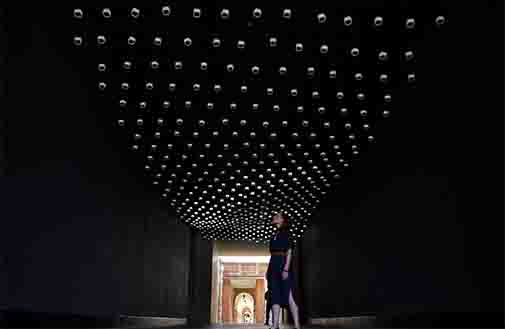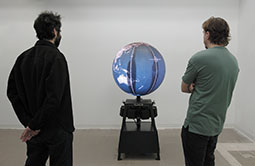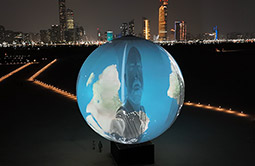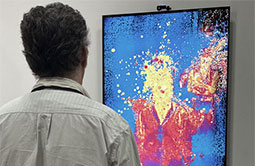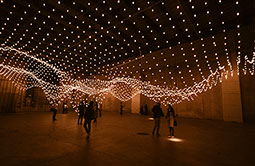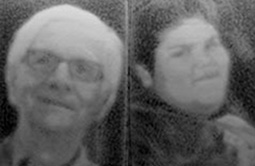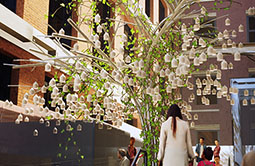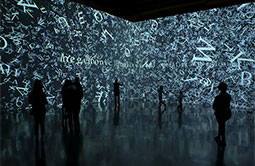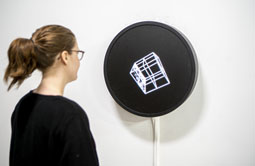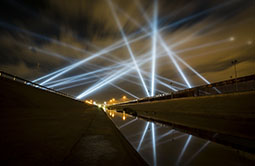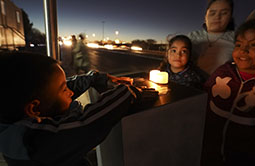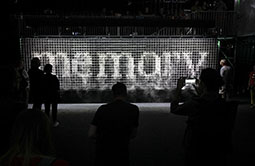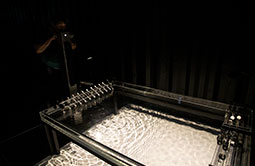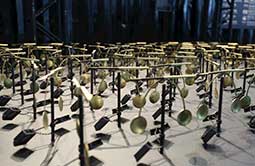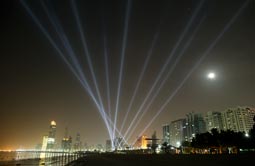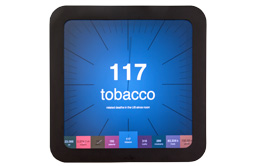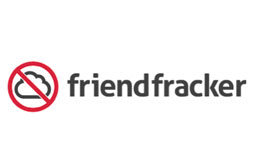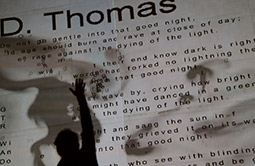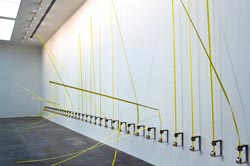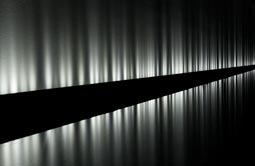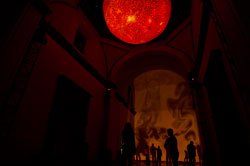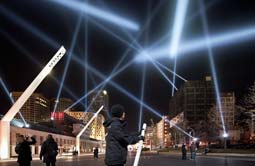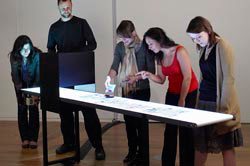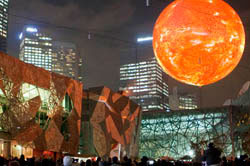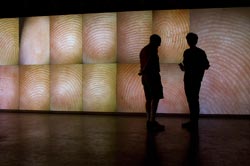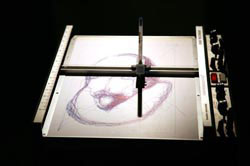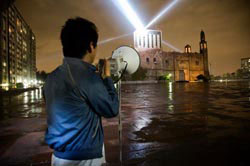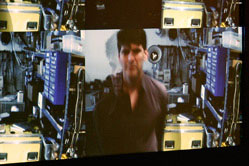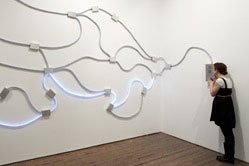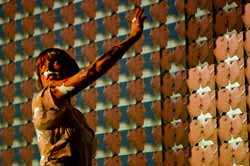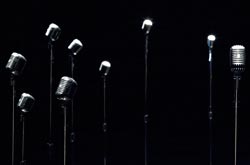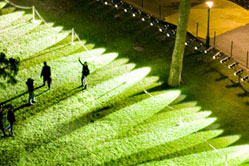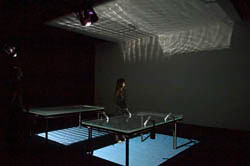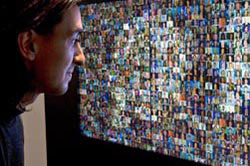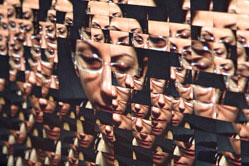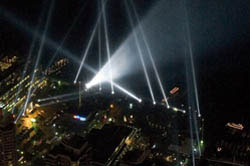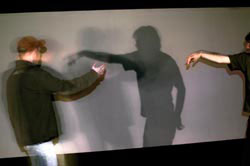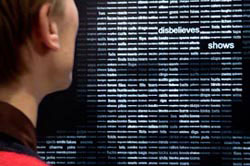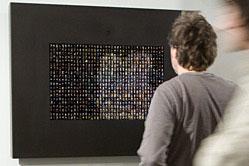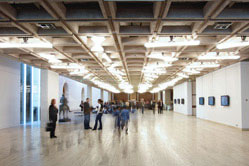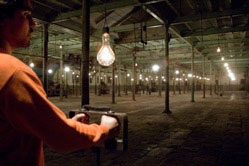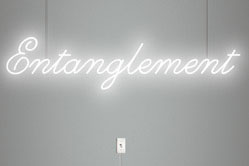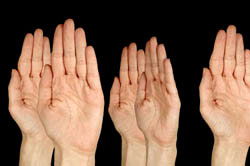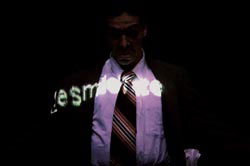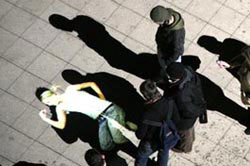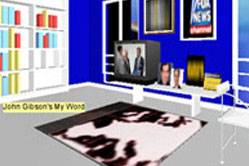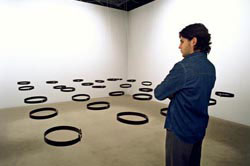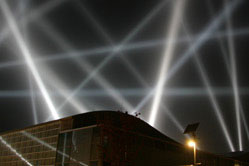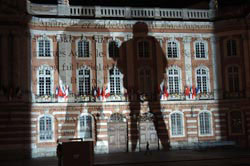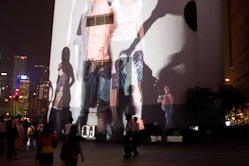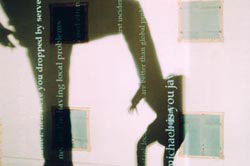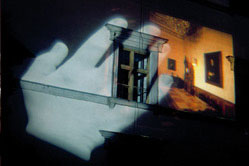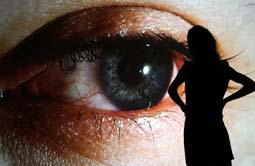Spectral Subjects
2024
“Spectral Subjects” is a thermal observatory, showing a constantly updating map of the room’s temperature on surround projections. Using thermographic cameras, the project detects heat and cold in the environment, including the building’s air circulation and ventilation, visitors’ body heat, and inanimate objects. The piece automatically mixes live feeds with recordings from the recent past, creating thermal echoes in the atmosphere, an evolving portrait of uncanny spectral traces that make the atmosphere tangible. This artwork is available as both a treatment and a standalone piece.
View details.
View details.
Binocular Tension
2024
“Binocular Tension” is a light box showing two human eyes that track and follow the observer with a built-in computerized tracking system. When a member of the public is detected, their presence triggers the eyes to wake up, looking at the visitor directly, creating an uncanny experience that questions who is the observer and who is the observed. Over 1,500 photographs were used to create this interactive stop-motion artwork. The piece is part of a series on surveillance that started in 1992 with “Surface Tension,” which shows a giant human eye following the observer with Orwellian precision. In this series of works, the artist creates a tangible manifestation of observation as the subject of the work of art. Here, eye contact is presented as a technological mechanism of sentience, seduction, policing, and control.
View details.
View details.
Pulse Voronoi
2024
One cubic metre of crystal explodes into 7,000 unique but complementary shards, expelled in all directions. "Pulse Voronoi" proposes a walk through the resulting cloud of crystals, shortly after the blast. The crystals are suspended in the room, each with a warm light that glimmers rhythmically to the recorded heartbeat of a different participant from the past. Five pulse sensors placed around the room detect visitors' heartbeats which can be heard in the room and seen in surrounding lights. Every new recording of vital signs deletes the oldest one, creating a memento mori.
View details.
View details.
Kristallstimmen
2024
An interactive installation for Swarovski’s “Crystal Worlds Museum” in Wattens, Austria, features an array of 3,000 suspended loudspeakers, each clad in hundreds of small black crystals that get illuminated when in use. As visitors traverse the space, sensors detect their presence and turn on the speaker directly above them, which lights up and plays a voice message. Each loudspeaker contains a recording from a different company employee from around the world, speaking in their native language about their relationship to crystal, with over 100 languages represented. When no visitor is present, the installation is silent.
View details.
View details.
Climate Parliament
2024
“Climate Parliament” is an interactive sound and light installation featuring thousands of audio channels playing on small, custom-made loudspeakers, suspended under the ceiling of a semi-outdoor passageway at Rice University. The speakers are hung out of reach of passers-by in a regular, but staggered formation that creates semi-circular archways with a six-foot radius.
View details.
View details.
Shadow Tuner - Standalone
2024
An animated image of the Earth rotates on a sphere. As people approach and move around it, their movements are tracked and reflected on the sphere as black shadows. As shadows cover different cities, they automatically trigger live, local radio stations from those locations, thus creating a global polyphonic tuning device. This artwork is available as both an inflatable public sculpture and a standalone domestic piece.
View details.
View details.
Shadow Tuner
2023
An animated image of the Earth rotates on a sphere. As people approach and move around it, their movements are tracked and reflected on the sphere as black shadows. As shadows cover different cities, they automatically trigger live, local radio stations from those locations, thus creating a global polyphonic tuning device. This artwork is available as both an inflatable public sculpture and a standalone domestic piece.
View details.
View details.
Arkansas Text Stream
Text Stream 9, 2022
“Arkansas Text Stream” (Text Stream 9) consists of brief texts sourced from Northwest Arkansas community members presented in a slow stream of letters that transform into phrases as the presence of people is detected. Commissioned by Crystal Bridges Museum of Art, Bentonville.
View details.
View details.
Thermal Drift
2022
“Thermal Drift” is an interactive artwork that visualizes the dispersion of body heat as emissions of thermal energy in the form of slow-moving packets or quanta that flow away from the participant. This artwork is available as both a projection and a standalone piece.
View details.
View details.
Thermal Drift Density Map
2022
“Thermal Drift Density Map” is an interactive artwork that visualizes the dispersion of body heat as emissions of thermal energy in the form of slow-moving packets or quanta that flow away from the participant. This artwork is available as both a projection and a standalone piece.
View details.
View details.
Banderoles
2021
Influenced by works such as Samuel Beckett’s theatre production made teleplay “Not I” (1972; 1975) and “Messa di Voce” performed by Golan Levin and Zach Lieberman with vocalist-composers Jaap Block and Joan La Babara (2003-2005), “Banderoles” continues the performative tradition of harnessing the visual power of the mouth and visualizing the human voice.
“Banderoles” uses voice and face recognition to capture an image of participants’ mouths and to create visual representations of the words being spoken.
View details.
View details.
Pulse Topology
2021
“Pulse Topology” uses remote photoplethysmography (PPG) technology, developed to detect heartbeats without using touch. The biometric data collected from participants is used to illuminate 3,000 to 10,000 suspended light bulbs, creating an immersive audio-visual experience which forms a connective topography of the pulses of participants.
View details.
View details.
A Crack in the Hourglass
2020
“A Crack in the Hourglass” is a transitory “anti-monument” in response to the pandemic and the ways it has halted public rituals of mourning. In this participatory artwork, a modified robotic plotter deposits grains of hourglass sand onto a black surface to recreate the images of those lost due to COVID-19.
View details.
View details.
Speaking Willow
2020
“Speaking Willow” is a sound sculpture in the shape of a weeping willow tree, between 16 and 20 feet high, which adorns the entrance of the Planet Word Museum. The tree sculpture is fabricated in aluminum and is hollow, except the trunk and branches carry inside data cables that emerge from the structure and hang vertically, slowly swaying with the wind. The tree is covered by living vine, Ivy or other evergreen climbing plants that warm-up the design.
View details.
View details.
Encode/Decode
2020
"Encode/Decode," a generative interactive typographical environment made from the critical essay of Jamaican-British cultural studies scholar Stuart Hall (1932-2014) in which he proposes an encoding/decoding model of communication.
View details.
View details.
Recurrent Rayuela
Text Stream 6, 2020
"Recurrent Rayuela" (Text Stream 6) is a generative artwork made with the 155 chapters of the experimental novel "Rayuela" (Hopscotch) published in 1963 by Argentine writer Julio Cortázar. The piece consists of a black circular screen that shows a cube with thousands of letters from the book in a fluid, animated pool. When the screen is manually rotated by a visitor, the cube tumbles around and the letters become turbulent; after a few seconds, random excerpts from the novel emerge on screen from the turbulence. As soon as the rotation ends the excerpts disappear and the pool of letters stabilizes again.
View details.
View details.
Border Tuner / Sintonizador Fronterizo
Relational Architecture 23, 2019
"Border Tuner" is a large-scale, participatory art installation designed to interconnect the cities of El Paso, Texas, and Ciudad Juárez, Chihuahua. Powerful searchlights make “bridges of light” that open live sound channels for communication across the US-Mexico border. The piece creates a fluid canopy of light that can be modified by visitors to six interactive stations, three placed in El Paso and three in Juárez.
View details.
View details.
Remote Pulse
2019
“Remote Pulse” is an interactive installation consisting of two identical pulse-sensing stations that are interconnected over the internet. When a person places their hands on one station automatically the person on the other station feels their pulse, as the plates vibrate in sync with the heartbeat of the remote person, and vice versa. The piece was originally presented as part of Lozano-Hemmer’s “Border Tuner” installation across the US-Mexico border.
View details.
View details.
Cloud Display
2019
“Cloud Display” is a vertical water fountain consisting of 1,600 ultrasonic atomizers, controlled by a machine-learning voice recognition system. When a participant speaks into an intercom, the piece writes any words or sentences spoken using wisps of pure water vapour. The project can work in most languages, and recognizes different accents.
View details.
View details.
Voice Tank
2019
“Voice Tank” is a ripple tank controlled by polyphonic pitch detection actuation. The voices of two participants who speak into the intercoms are analyzed and converted into notes hammered by motorized components. The resulting waves interact and create unique patterns.
View details.
View details.
Weather Vanes
2019
“Weather Vanes” is an artwork that features 99 brass arrows inspired by anemometers and weather vanes, the devices used to measure wind speed and direction. Here, live voices control miniature computerized fans that create turbulence. When seen from above, the table looks like a map of wind barbs or vectors.
View details.
View details.
Recognition
2018
"Recognition" is a machine-learning face recognition algorithm that classifies the viewer in relation to a constantly growing database of people who have seen the work in the past. This artwork is available as both a projection and a standalone piece.
View details.
View details.
Polar
2018
A circular display that converts a camera’s cartesian grid of photo sensors into a representation in polar coordinates (an angle and a distance). The piece has a radar-like rotation mapped to the baseline of the live camera to add an element of time, emphasized by a quiet ticking sound. The polar distortion produces an anamorphic representation of people in front of the work, with all of them sharing the same origin.
View details.
View details.
Colorimètre
2017
A permanent comission for Maison Manuvie building in Montreal. The piece consists of 500 colour panels arranged in a grid. The piece features a surveillance system that does not track people, but rather saturated colors that may be present in the atrium. When a saturated colour is detected, the camera automatically zooms and tracks it so the atrium itself adopt the colour.
View details.
View details.
Pulse Corniche
Relational Architecture 22, 2015
“Pulse Corniche” (Relational Architecture 22) was an interactive canopy of powerful light beams projected into to the sky by robotic searchlights whose brightness and orientation was controlled by the heart-rate of visitors to the Abu Dhabi’s Corniche. People were free to participate by holding a sensor placed in the centre of the plaza that converted the electrical activity of their heart into a unique lighting sequence. The intensity and direction of the lights visualized the different biometric rhythms of each participant, in an urban scale.
View details.
View details.
Zero Noon
2013
"Zero Noon" is a digital clock that shows the current time according to eccentric metrics: it uses hundreds of different internet-refreshed statistics. The clock's reference systems are all synchronized so that precisely at noon they all zero and start over. The public may change the statistics by manually scrolling through the list using small push-buttons under the built-in display. The metrics come from government data, Harper’s Magazine, financial institutions, NGOs, academic studies and other trusted sources.
View details.
View details.
Friendfracker
2013
“Friendfracker” is a service that automatically deletes a set of friends from your Facebook account. Upon authenticating your data on the website, the service deletes 1 to 10 friends at random. The project was developed with Harper Reed for Rhizome's 7 on 7 conference.
View details.
View details.
Airborne Newscasts
Relational Architecture 20, 2013
"Airborne Newscasts" (Relational Architecture 20) is an interactive installation originally commissioned by the Chrysler Museum of Art to transform Norfolk, Virginia’s public space into a poetic shadow play. By blocking the light of two projectors, participants cast their shadows onto a 900-square-metre wall, and these shadows are tracked by computerized surveillance systems. Out of the shadows emanate billowing smoke which is mapped onto the wall, slowly accumulating within it. Turbulent clouds of live newscasts evaporate from the “heat” of the tracked bodies.
View details.
View details.
Tape Recorders
Subsculpture 14, 2011
In “Tape Recorders” (Subsculpture 14), rows of motorised measuring tapes record the amount of time that visitors stay in the installation. As a computerised tracking system detects the presence of a person, the closest measuring tape starts to project upwards. When the tape reaches around 3 meters high it crashes and recoils back. Each hour, the system prints the total number of minutes spent by the sum of all visitors.
View details.
View details.
Voice Array
Subsculpture 13, 2011
In “Voice Array” (Subsculpture 13), as a participant speaks into an intercom, his or her voice is automatically translated into flashes of light and then the unique blinking pattern is stored as a loop in the first light of the array. Each new recording pushes all previous recordings one position down and gradually one can hear the cumulative sound of the 288 previous recordings. The voice that was pushed out of the array can then be heard by itself.
View details.
View details.
Nave Solar
2011
“Nave Solar” is an interactive installation featuring a fake Sun that is activated by the pendular motion of the public as they hang from a rope and swing along the nave of a 16th Century catholic inquisition church. Using tracking systems, the installation detects the motion of participants and generates smoke that accumulates on the ceiling of the apse as well as activates the Sun's flares, surface turbulence and sun spots.
View details.
View details.
Articulated Intersect
Relational Architecture 18, 2011
"Articulated Intersect" (Relational Architecture 18) is a large-scale installation that produces an interactive canopy of light that can be modified by the public using six large lever-controllers that protrude from the ground. As a participant points one of these levers three powerful robotic searchlights automatically intersect in the sky to create an apex at that location. The participant may direct the apex anywhere over the city in real-time, creating an animated tetrahedron inspired by the work of Richard Buckminster Fuller.
View details.
View details.
Please Empty Your Pockets
Subsculpture 12, 2010
“Please Empty your Pockets” (Subsculpture 12) is an installation that consists of a conveyor belt with a scanner that records and accumulates everything that passes under it. The public may place any small object on the conveyor belt: once it passes under the scanner, the object reappears on the other side beside projected objects from the memory of the installation. As a real item is removed from the conveyor belt, it leaves behind a projected image of itself, which is then used to accompany future objects. The piece remembers up to 600,000 objects which are displayed beside new ones that are added to the installation.
View details.
View details.
Solar Equation
Relational Architecture 16, 2010
"Solar Equation" is a large-scale public art installation that consists of a faithful simulation of the Sun, 100 million times smaller than the real thing. Commissioned by the Light in Winter Festival in Melbourne, the piece features the world’s largest spherical balloon, custom-manufactured for the project, which is tethered over Federation Square and animated using five projectors. The solar animation on the balloon is generated by live mathematical equations that simulate the turbulence, flares and sunspots that can be seen on the surface of the Sun. This produces a constantly changing display that never repeats itself, giving viewers a glimpse of the majestic phenomena that are observable at the solar surface and that only relatively recent advances in astronomy have discovered. Using an iPhone, iPod touch or iPad, people may disturb the animations in real-time and select different fluid dynamic visualizations.
View details.
View details.
Pulse Index
2010
"Pulse Index" is an interactive installation that records participants’ fingerprints at the same time as their heart rates. The piece displays data for the last 765 and over participants in a stepped display that creates a horizon line of skin. As new recordings are added, the oldest ones disappear, —a kind of memento mori. To participate, people introduce their finger into a custom-made sensor equipped with a digital microscope and a heart rate sensor; their fingerprint immediately appears on the largest cell of the display, pulsating to their heart beat.
View details.
View details.
Cardinal Directions
Subsculpture 11, 2010
"Cardinal Directions", is a kinetic sculpture which consists of a surveillance monitor that displays an extract of Vicente Huidobro´s poem "Altazor" (1919-1931). Refering to the geography of his native Chile, Huidobro wrote "The four cardinal directions are three: North and South". When a presence is detected by infrared sensors, the monitor starts to rotate. As the poem is "geolocated" it always aligns itself to the cardinal points, and the public must walk around the piece in order to read it, like a kind of periscope.
View details.
View details.
The Company of Colours
Shadow Box 9, 2009
"The Company of Colours" (Shadow Box 9) is the ninth piece in the Shadow Box series of interactive displays with a built-in computerized tracking system. This piece shows the live camera view constructed out of a palette of named colour swatches that can be rendered by computers. Every few minutes the piece automatically switches to show the live view made with a variety of culturally-significant colour palettes from computer and video game history, including the four shades of green of the original Nintendo Gameboy, the eight colours of teletext, and the 16 colours of the Commodore 64, the Apple II and the ZX Spectrum.
View details.
View details.
Seismoscopes
2009
The series "Seismoscopes" consists of devices that detect vibration around them, from footsteps to earthquakes, and record this vibration on paper using an automated XY-plotter. As each Seismoscope registers any seismic wave it is programmed to draw an illustration of a single Skeptical philosopher, over and over again.
View details.
View details.
Voz Alta
Relational Architecture 15, 2008
"Voz Alta" (Loud Voice)(Relational Architecture 15) is a memorial commissioned for the 40th anniversary of the student massacre in Tlatelolco. Participants who speak into a megaphone automatically control the brightness of four searchlights that relay their voice over Mexico City as quiet light flashes; tuning into 96.1FM radio allows people anywhere in the city to listen in live to what the lights are saying.
View details.
View details.
Alpha Blend
Shadow Box 7, 2008
"Alpha Blend" (Shadow Box 7) is an interactive display with a built-in computerized tracking system that show the viewer's presence, revealing and blending pictures of people who have previously looked at the work. A game of "reverse puppetry" ensues, where a portrait from the past is animated by a live presence, in a similar perceptual mechanism than the one used in Lozano-Hemmer's public art installation "Body Movies" (2001).
View details.
View details.
Less Than Three
2008
"Less than Three" is an interactive installation of light strips that form a network between two intercoms. As a participant speaks into an intercom, their voice is translated into corresponding flashes of light and this light pattern is transmitted visually along one of the several possible pathways through the network. When it reaches the other side, the viewer's phrase is once again released as sound. Several voices can be carried simultaneously and the short contributions going fast through the network and the longer ones taking longer.
View details.
View details.
Make Out
Shadow Box 8, 2008
"Make Out" (Shadow Box 8) is an interactive piece showing thousands of internet videos of couples looking at each other. As soon as a participant stands in front of the display his or her silhouette is shown and all the couples within it begin to kiss. The massive array of make-out sessions continues for as long as someone is in front of the work—as he or she moves away all the kissing ends.
View details.
View details.
Microphones
Subsculpture 10, 2008
"Microphones" (Subsculpture 10) is an interactive installation featuring one or several 1939-vintage Shure microphones, placed on mic stands around the exhibition room at different heights. Each microphone has been modified so that inside its head is a tiny loudspeaker and a circuit board connected to a network of hidden control computers. When a public member speaks into a microphone, it records his or her voice and immediately plays back the voice of a previous participant, as an echo from the past.
View details.
View details.
Pulse Park
Relational Architecture 14, 2008
"Pulse Park" (Relational Architecture 14) is comprised of a matrix of light beams that grazed the central oval field of Madison Square Park, New York City. The intensity of each spotlight is entirely modulated by a sensor that measures the heart rate of participants. The resulting effect is a visualization of the body's vital signs, arguably our most symbolic biometric, at an immense scale and in an urban setting.
View details.
View details.
Pulse Spiral
2008
"Pulse Spiral" is a three-dimensional spiral paraboloid made up of 400 lightbulbs arranged according to Fermat's equations, which records and responds to the heart rate of participants who hold a sensor underneath. Commissioned for the opening of the Center for Contemporary Culture in Moscow in the constructivist Bakhmetevsky Bus Garage, the piece is inspired by engineer Vladimir Shukov who worked with Melnikov on this emblematic building from 1926-28.
View details.
View details.
Pulse Tank
2008
"Pulse Tank" is an Interactive installation where the heart rates of members of the public are detected by sensors and converted into water waves in a ripple tank. A light show is created by the resulting waves and their interaction. To participate, insert your finger into one of the four cylinders on the side of the tank or put your hands flat on the front panel; the computer will detect your pulse and activate a solenoid which will hammer your heart rate onto the tank.
View details.
View details.
Reporters With Borders
Shadow Box 6, 2007
"Reporters With Borders" (Shadow Box 6) is a high-resolution interactive display that simultaneously shows 864 video clips of news anchors taken from TV broadcasts in the United States and Mexico. As the viewer stands in front of the piece his or her silhouette is shown on the display and within it reporters begin to talk. Every 5 minutes the piece switches the video clips - from a database of 1600 - and classifies them along gender, race and country, so that for instance on the left there are only American reporters and on the right only Mexicans.
View details.
View details.
Wavefunction
Subsculpture 9, 2007
"Wavefunction" (Subsculpture 9) is a kinetic sculpture comprised of fifty to one hundred Charles and Ray Eames moulded chairs (designed in 1948) and placed in a regular array of rows, facing the entrance to the exhibition space. When someone approaches the work, a computerised surveillance system detects their presence and the closest chairs automatically begin to lift off the ground, creating the crest of a wave that then spreads over the whole room.
View details.
View details.
Blow Up
Shadow Box 4, 2007
"Blow-up" (Shadow Box 4) is an interactive piece designed to fragment a surveillance camera view into 2400 virtual cameras that zoom into the exhibition space in a fluid and autonomous motion. Inspired by 20th-century Italian filmmaker Michelangelo Antonioni, the piece is intended as an exercise to underline the construction of presence through a simulated, live compound eye.
View details.
View details.
Pulse Front
Relational Architecture 12, 2007
"Pulse Front" (Relational Architecture 12) was an interactive light installation over Toronto's Harbourfront Centre, consisting of a matrix of light beams from twenty powerful robotic searchlights controlled by a network of sensors that measured the heart rate of passers-by. Ten metal sculptures detected and measured the pulse of people who held them and their readings were immediately converted into light pulses and also determined the orientation of the beams.
View details.
View details.
Sustained Coincidence
Subsculpture 8, 2007
"Sustained Coincidence" (Subsculpture 8) is an interactive installation activated by the spatial relationships of visitors within a gallery. The piece consists of a series of incandescent lightbulbs that light up in reaction to the participants’ positions, in such a way that the shadows cast on the opposing wall are always overlapping. The piece is inspired by the phantasmagorias on the one hand and surveillance and digital analysis on the other.
View details.
View details.
Close-up
Shadow Box 3, 2006
"Close-up", the third piece of the Shadow Box series, is an interactive piece in which a participant's silhouette reveals hundreds of tiny videos of other people who have previously looked at the work. When a viewer approaches the piece, the system automatically starts recording and makes a video of him or her. Simultaneously, inside the viewer's silhouette, videos are triggered, showing up to 800 recent recordings. This piece presents a schizoid experience where one’s presence triggers a massive array of surveillance videos.
View details.
View details.
Third Person
Shadow Box 2, 2006
"Third Person" (Shadow Box 2) is the second piece of the ShadowBox series of interactive displays with a built-in computerized tracking system. This piece shows the viewer's shadow revealing hundreds of tiny words that are in fact all the verbs of the dictionary conjugated in the third person. The portrait of the viewer is drawn in real time by active words, which appear automatically to fill his or her silhouette. The collector may choose to display the words in English, Spanish or French, or a combination of the three languages.
View details.
View details.
Eye Contact
Shadow Box 1, 2006
"Eye Contact" (Shadow Box 1) is the first piece of the Shadow Box series of interactive displays with a built-in computerized tracking system. This piece shows eight hundred simultaneous videos of people lying down, resting. As soon as a public member is detected, his or her presence triggers the miniature video portraits to wake up: hundreds of people simultaneously turn to look at the visitor directly, creating an uncanny experience that questions who is the observer and who is the observed.
View details.
View details.
Homographies
Subsculpture 7, 2006
"Homographies" (Subsculpture 7) is a large-scale interactive installation featuring a turbulent light array that responds to the movement of the public using a surveillance tracking system. The installation consists of white fluorescent light tubes hung from robotic fixtures on the ceiling of the exhibition space, equally spaced. Each light tube rotates slowly using a computerized stepper motor and create labyrinthine patterns of light that make "paths" or "corridors" between people. All lights are always on and typically constitute the only lighting in the exhibition hall, except for the natural light that spills into the space.
View details.
View details.
Pulse Room
2006
"Pulse Room" is an interactive installation featuring one to three hundred clear incandescent light bulbs, 300 W each and hung from a cable at a height of three metres. The bulbs are uniformly distributed over the exhibition room, filling it completely. An interface placed on a side of the room has a sensor that detects the heart rate of participants. When someone holds the interface, a computer detects his or her pulse and immediately sets off the closest bulb to flash at the exact rhythm of his or her heart.
View details.
View details.
Entanglement
Subsculpture 6, 2005
"Entanglement" (Subsculpture 6) is an interactive installation that consists of two identical neon signs, each measuring 182 x 38 cm. The signs simply state the word "Entanglement", a term used in quantum physics to describe the strange property exhibited by two particles that behave as one. The two signs are connected and do not work independently, turning on and off together by way of a basic light switch, even if the entangled pair is in different cities and in separate rooms.
View details.
View details.
Glories of Accounting
Subsculpture 5, 2005
"Glories of Accounting" (Subsculpture 5) is an interactive installation with a surveillance system that detects the position of the public in the exhibition room. When someone walks into the room, large hands appear on the screen automatically. The hands rotate along their forearm axis, following the visitor with the open palms always facing them. As more viewers enter the room, more hands appear, each one following a member of the public.
View details.
View details.
Subtitled Public
2005
"Subtitled Public" consists of an empty exhibition space where visitors are detected by a computerised surveillance system. When people enter the space, the system generates a subtitle for each person and projects it onto him or her: the subtitle is chosen at random from a list of all the verbs conjugated in the third person. The only way of getting rid of a subtitle is to touch another person, which leads to the two subtitles being exchanged.
View details.
View details.
Under Scan
Relational Architecture 11, 2005
"Under Scan" (Relational Architecture 11) is a public art installation based on self-representation. Thousands of "video-portraits" taken in Derby, Leicester, Lincoln, Northampton and Nottingham are projected onto the ground; at first, the portraits are not visible because the space is flooded by white light coming from a high-powered projector. As people walk around the area, their shadows are cast on the ground, revealing the video-portraits in short sequences.
View details.
View details.
Sitestepper
Relational Architecture 10, 2004
"Sitestepper" (Relational Architecture 10) is an Internet program that shows a 3D view of an apparently "neutral" living room. This space can be transformed automatically by scanning a website to extract its images, texts, colours and sounds. The system analyzes the contents of the submitted webpage and uses them to furnish and decorate the room, "branding" the space with a layer of live media. This project was commissioned for LA MOCA's digital gallery.
View details.
View details.
Standards and Double Standards
Subsculpture 3, 2004
"Standards and Double Standards" (Subsculpture 3) is an interactive installation that consists of 10 to 100 fastened belts that are suspended at waist height from stepper motors on the ceiling of the exhibition room. Controlled by a computerized tracking system, the belts rotate automatically to follow the public, turning their buckles slowly to face passers-by. When several people are in the room their presence affects the entire group of belts, creating chaotic patterns of interference. Non-linear behaviours emerge such as turbulence, eddies and relatively quiet regions.
View details.
View details.
Amodal Suspension
Relational Architecture 8, 2003
“Amodal Suspension" (Relational Architecture 8) is a large-scale interactive installation in which people send short text messages to each other using a cell phone or web browser. However, rather than being sent directly, the messages are encoded as unique sequences of flashes with twenty robotically-controlled searchlights, not unlike the patterns that make up Morse code. Messages "bounce" around from searchlight to searchlight, turning the sky into a giant switchboard.
View details.
View details.
Two Origins
Relational Architecture 7, 2002
“Two Origins” (Relational Architecture 7) is an intervention in which the emblematic Place du Capitole in Toulouse was transformed by a projection of The Book of Two Origins, a 13th-century heretical manuscript compiling the theological beliefs of the dualist cathars. Once a vibrant community in several regions of Europe, the believers in the two origins of the Universe were virtually annihilated by the brutal crusades that gave birth to the Inquisition and France's expansion. The texts are illegible since they are projected overlapping each other on the same façade from two distant projectors; only when passers-by block one text with their bodies is it possible to read the other text inside their shadow.
View details.
View details.
Body Movies
Relational Architecture 6, 2001
"Body Movies" transforms public space with interactive projections measuring between 400 and 1,800 square metres. Thousands of photographic portraits, previously taken on the streets of the host city, are shown using robotically controlled projectors. However the portraits only appear inside the projected shadows of the passersby, whose silhouettes can measure between two and twenty-five metres depending on how close or far away they are from the powerful light sources positioned on the ground.
View details.
View details.
33 Questions per Minute
Relational Architecture 5, 2000
"33 Questions Per Minute" (Relational Architecture 5) consists of a computer program which uses grammatical rules to combine words from a dictionary and generate 4.7 trillion unique, fortuitous questions. The automated questions are presented at a rate of 33 per minute—the threshold of legibility. The system will take over 271,000 years to ask all possible questions.
View details.
View details.
Vectorial Elevation
Relational Architecture 4, 1999
"Vectorial Elevation" (Relational Architecture 4) is an interactive art project originally designed to celebrate the arrival of the year 2000 in Mexico City's Zócalo Square. The website www.alzado.net enabled any Internet user to design light sculptures over the city's historic centre, with eighteen searchlights positioned around the square. These searchlights, whose powerful beams could be seen within a 15 kilometers radius, were controlled by an online 3D simulation program and visualised by digital cameras. A personalised webpage was produced for every participant with images of their design and information such as their name, dedication, place of access and comments.
View details.
View details.
Re:Positioning Fear
Relational Architecture 3, 1997
"Re:Positioning Fear" (Relational Architecture 3) was a large-scale installation on the Landeszeughaus military arsenal with a "teleabsence" interface of projected shadows of passers-by. Using tracking systems, the shadows were automatically focused and generated sounds. A real-time IRC discussion about the transformation of the concept of "fear" was projected inside the shadows; the chat involved 30 artists and theorists from 17 countries.
View details.
View details.
Displaced Emperors
Relational Architecture 2, 1997
"Displaced Emperors" (Relational Architecture 2) was an interactive installation that used an "architact" —architecture meets haptics— interface to transform the facade of the Habsburg Castle in Linz, Austria. Wireless 3D sensors calculated where participants pointed to on the façade and a large animated projection of a hand was projected at that location. As people on the street "caressed" the building, they could reveal the interiors of the Habsburg residence in Mexico City, Castillo de Chapultepec.
View details.
View details.
Surface Tension
1992
"Surface Tension" is an interactive installation where an image of a giant human eye follows the observer with orwellian precision.This work was inspired by a reading of Georges Bataille's text The Solar Anus during the first Gulf War: first wide-spread deployment of camera-guided "intelligent bombs". Present-day computerised surveillance techniques employed by the Department of Homeland Security in the United States through the Patriot Act, provide a new and distressing backdrop for this piece.
View details.
View details.




